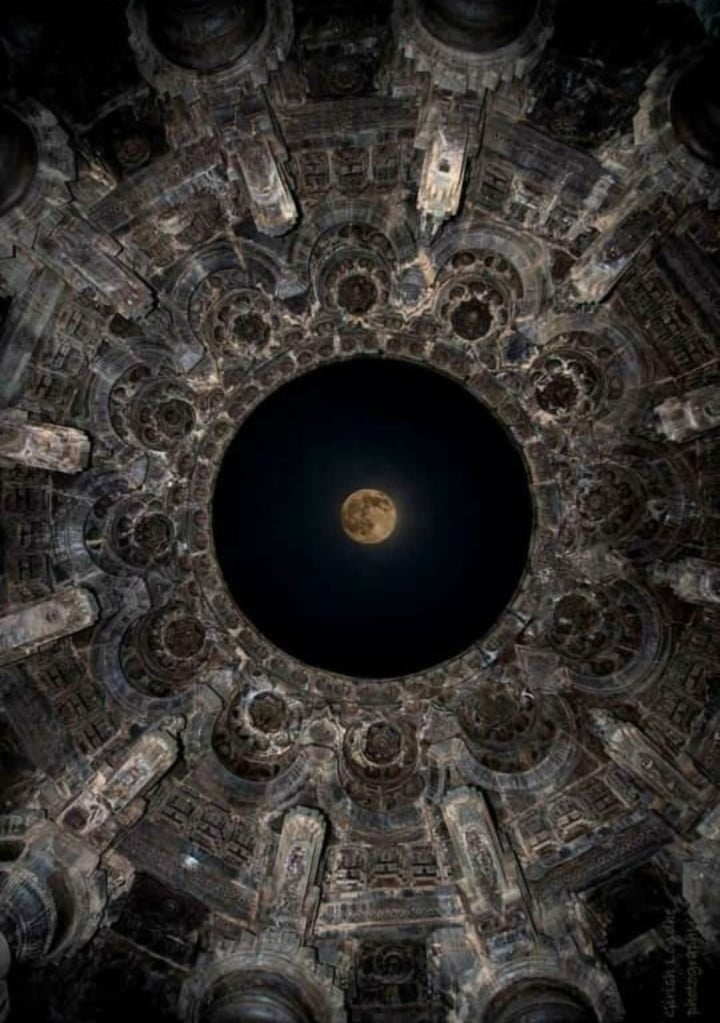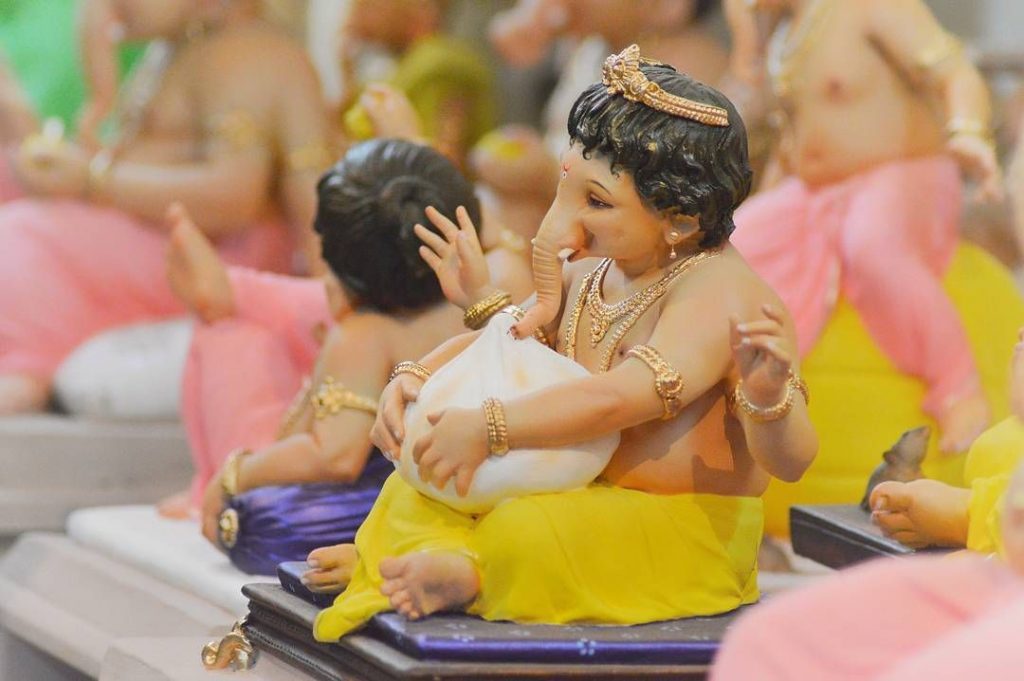As you journey along the NH48, slicing through the heart of western Maharashtra, you find yourself in a realm where the air is thick with the sweet scent of sugarcane and the horizon is dotted with bustling towns. This region, known for its industrious landscapes, hides within it a road less travelled that diverges from the main artery. Venture off this beaten path by booking a car rental from Kolhapur, and the scenery transforms. You find yourself driving through lush fields, where the verdant greenery stretches out endlessly.
In this secluded haven, far from the clamour of city life, you wouldn’t expect to stumble upon a treasure. Yet, as if by magic, an architectural jewel reveals itself, standing as a silent witness to centuries of history and devotion. This is no ordinary temple; it is a masterpiece cloaked in mystery, an ode to the gods crafted by the hands of forgotten artisans. This temple, a serene sanctuary nestled on the banks of the River Krishna, holds within its walls a unique confluence of divine presence.
It is the only place in the country where Lord Shiva and Lord Vishnu, two of Hinduism’s greatest deities, are venerated side by side in a rare harmony. This is also where Vishnu is present in the “linga” form. Dating back approximately 1700 years, this site has been dubbed the Khajuraho of Maharashtra for its intricate sculptures and carvings that dance across its stone walls. This hidden gem, veiled by the folds of nature and history, is Shree Kopeshwar Mandir, located in the quaint village of Khidrapur. This temple invites you to step into a story centuries in the making, urging you to uncover the stories etched in its stones.
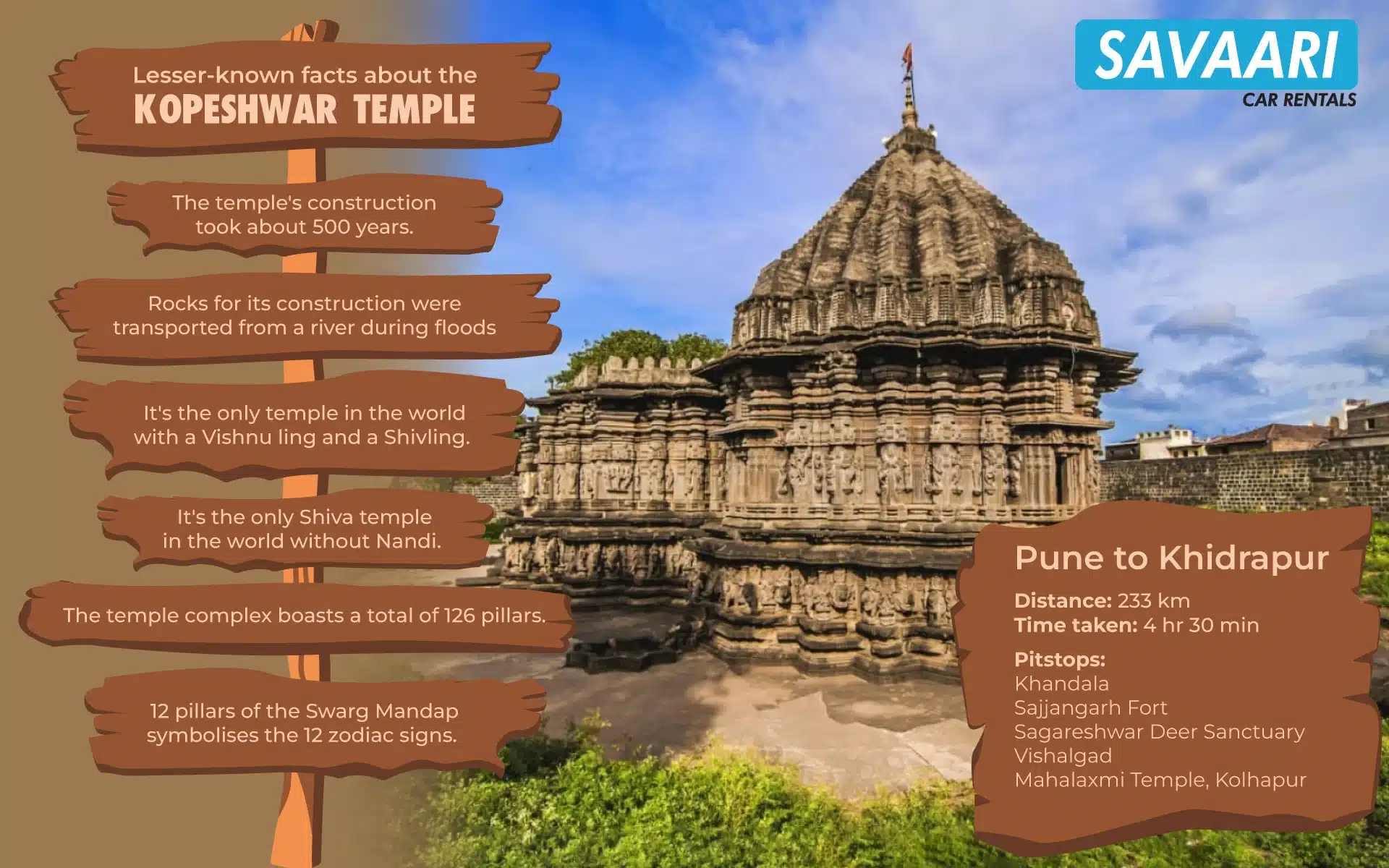
The legend of Kopeshwar Temple – From fury to peace
Nestled in mythology, the origins of the Kopeshwar Temple unfold through a tale of divine wrath and reconciliation. It all began with Daksha’s disapproval of his daughter Sati marrying Shiva. Ignoring the couple, Daksha organized a Yagna. Sati rode on Shiva’s bull Nandi, and confronted her father, only to be publicly humiliated. In her anguish, Sati sacrificed herself in the Yagna’s flames, enraging Shiva, who severed Daksha’s head.
Vishnu intervened, calming Shiva and restoring Daksha’s life, albeit with a goat’s head. Seeking solace, Vishnu led Shiva to the site where Kopeshwar Temple now stands, hence its name, meaning ‘the wrathful god’. “Kopa” translates to anger in Kannada, which may be inspired by the geographical location of the temple and its proximity to Karnataka. Inside, both Shiva and Vishnu are worshipped, yet notably, Nandi is absent. This Khidrapur temple encapsulates the divine saga of wrath, reconciliation, and calm beautifully in its architecture.
The saga of Kopeshwar Temple’s construction
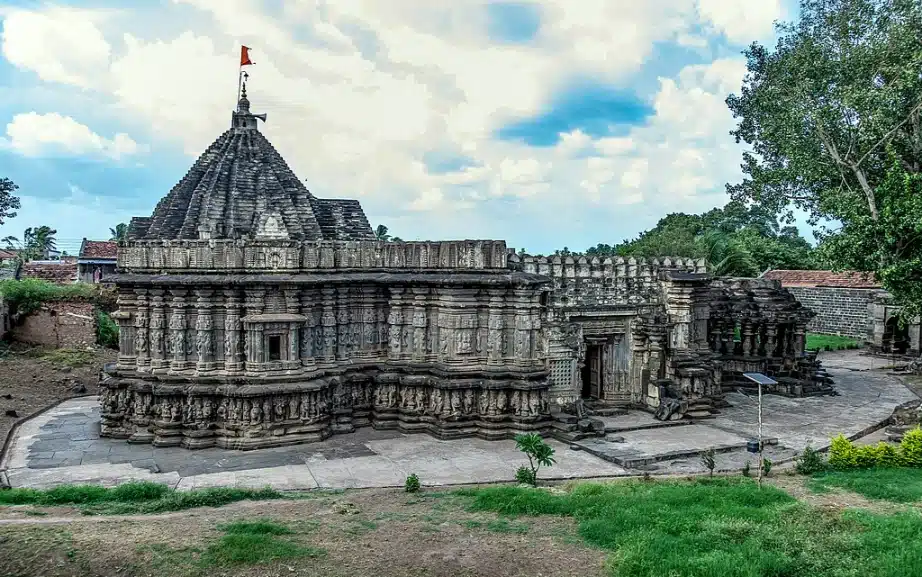
Kopeshwar Temple history is traced back to the 7th century AD, believed to have been initiated during the Chalukya dynasty’s reign. However, the tumultuous era marked by frequent conflicts among rival kings hindered its progress. It often left the project abandoned for extended periods. It wasn’t until the rule of Silhara ruler Gandaraditya, followed by the Yadava kings of Devgiri, nearly 500 years later in the 12th century, that the temple’s construction saw completion. These pivotal moments in history depict the temple’s enduring journey towards fruition.
How the Panchganga river built Kopeshwar Temple
The construction of Kopeshwar Temple unfolded over a span of 300-400 years. It is crafted from black basalt, a volcanic igneous rock sourced from the Sahyadri ranges. Black basalt, renowned for its durability, posed a formidable challenge to the temple’s artisans, whose skillful hands shaped its form over generations.
The transportation of these colossal stones was an arduous feat, facilitated by the flow of the Panchganga River. Rocks, carefully placed on wooden planks, could only be diverted during floods when the river’s current surged. This natural conduit through the Sahyadri range facilitated the transportation of materials. This most likely contributed to the prolonged construction period of 500 years.
Despite the passage of time, the temple’s architectural style remained steadfast. It is characterised by intricate carvings and an interlocking pattern reminiscent of structures like Kedarnath, whose architecture is detailed in this guide. The surrounding landscape is elevated by the accumulation of sand used in the temple’s construction. It stands in stark contrast with its white hue against the backdrop of the surrounding terrain.
This sand, sourced from unknown origins, played a crucial role in the temple’s creation. As the rocks were rolled upwards and carefully placed, the sand served as both foundation and support. It culminated in the majestic edifice that stands today. The elevated village surrounding the temple bears witness to the remnants of this monumental endeavour. It is immortalized in the very landscape it helped shape.
Unravelling the architectural splendour of Kopeshwar Temple
The Kopeshwar Temple is one of the oldest temples in India and stands as a striking star-shaped structure comprising four distinct sections: Swarg mandap, Sabha mandap, Antaral Kaksha, and Garbha Griha. This temple is in four parts, all interconnected through vestibules. Adjacent to the temple complex lies the Nagar Khana. It is also known as Nagad Khana, where the beats of Nagada drums once resounded.
Swarg Mandap
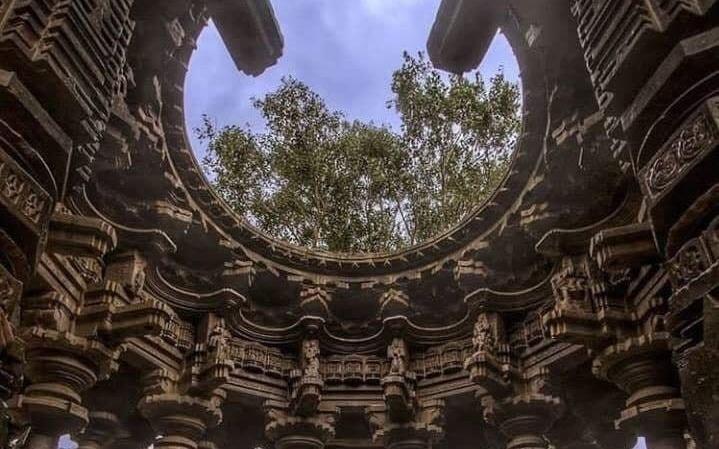
The first structure you enter through is the Swarg Mandap (Heavenly Hall). Swarg Mandap, marking the temple’s entrance, is a rarity found in only two temples across Maharashtra. The most elaborate Swarg Mandap resides in Khidrapur. Its external pillars, jutting from the temple’s foundation, symbolise strength and power. It is adorned with intricate carvings depicting wild goats, elephants, and other animals, along with oxen and crooked horns. Sculptures of the divine trinity—Lord Brahma, Vishnu, and Mahesh—are guarded on both the temple’s rear and side, with Lord Shiva’s presence signifying its dedicated devotion to him.
In the past, on that platform, performers showcased their talents by singing and dancing before Kopeshwar, with spectators gathered around the Swarg Mandap. Standing in the center of this area, you are treated to a view of the blue sky. It gives you the feeling that all the deities are showering their blessings upon you.
At the centre of the ground, there’s a massive, perfectly circular rock called the Ranga Sheela. It’s believed that this rock was originally intended to be placed atop something. Considering its considerable weight and the precision of its shape, which appears almost machine-cut, it raises questions about how it was shaped so accurately during that time. It seems it was carved right where it lies.
Many speculate that the Swarg Mandap once had a roof that has since collapsed. However, examining the design of the nearby pillars and the presence of a water drainage system next to the Ranga Sheela suggests that the Swarg Mandap was intentionally designed without a roof from the start of the temple’s construction.
The astronomical significance of Swarg Mandap
The Swarg Mandap boasts a total of 48 pillars, with 12 of them forming a circular arrangement at its centre, symbolising the 12 zodiac signs. Every year on Tripurari Poornima (Kartik Purnima), an extraordinary event occurs: the full moon perfectly aligns with a window at the centre of these pillars precisely at 12:03 am. This remarkable phenomenon showcases the meticulous planning behind the temple’s architecture.
Not only is the temple aligned with the eight cardinal directions, but it also harmonises with celestial bodies. It marks this auspicious occasion, which coincides with Diwali’s Tripurari Purnima, with unparalleled precision. Additionally, during the summer months from May 4th to May 8th, sunlight directly illuminates the Shivling in the Garba Graha.
Sabha Mandap
The Sabha Mandap, an integral part of the temple complex, stands somewhat apart from the Swarg Mandap. Its entrance is marked by an exquisite doorjamb, crowned with a statue of Saraswati. It is also flanked by Purna Kalash symbols on both sides. The lower sections beside the door feature 10 guardian figures, known as Dwarpalas, split evenly across each side. Despite some damage to their maces, these figures retain their beauty, thanks to their intricate ornamentation. Below them, a panel depicts mythical creatures called Vyals, adding to the mystical ambiance. The lattice windows, adorned with flower carvings at the cross sections, exemplify the distinct Chalukyan architectural style.
An unfinished Chandrashila adds a touch of intrigue at the doorway. Within the Sabha Mandap, the layout mirrors that of the Swarga Mandap but with a covered ceiling. Sixty pillars are strategically placed in three tiers The innermost forming a square and the outermost integrated into the walls. The four pillars at the corners are notably larger, and each pillar is engraved with a Kirtimukh in various designs. It features motifs such as peacocks, crocodiles, dancers, divine mounts like Garuda, and deities including Vishnu and Shiva, along with Sadhus, fruits, and flowers. The polish on the black basalt stones reflects light as if it were a mirror.
Antaral Kaksha
Antaral Kaksha, the third section, boasts numerous sculptures depicting tales from the ancient Panchatantra, Ramayana, and various mythological narratives. It is kept intentionally dark, fostering a meditative ambience conducive to prayer. Notably, the inclusion of statues representing Jain Tirthankars and saints from other faiths underscores the temple’s inclusive ethos.
Garbha Griha
Garbha Griha, the sanctum sanctorum, houses the linga of Vishnu (Dhopeshwar) and the Shivling “Kopeshwar,” facing north. While the entire temple remains under the jurisdiction of ASI, only Brahmins are permitted to enter the Garbha Griha, and only twice for the morning and evening rituals.
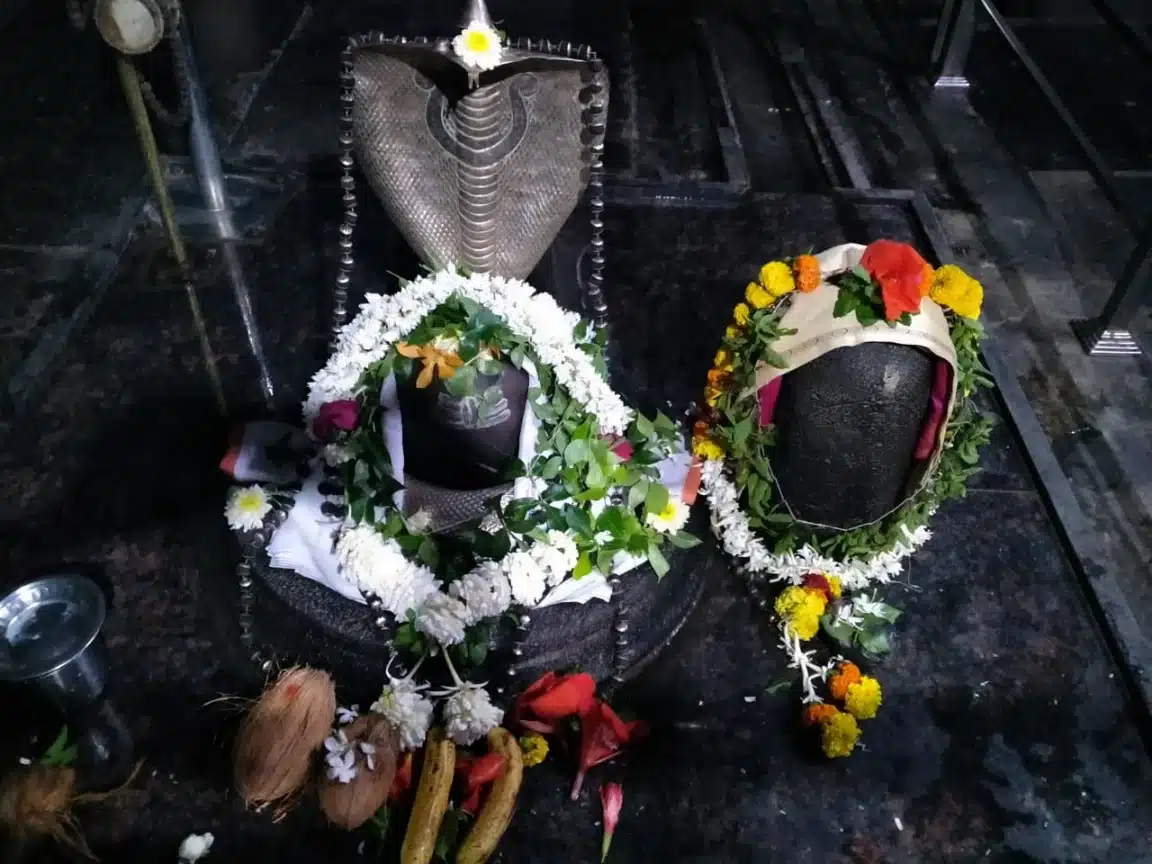
Delving into the architectural marvels of Kopeshwar Temple reveals a unique aspect. Each part of this temple is distinct from the others, ensuring that visitors are constantly mesmerised. The sculptures throughout the Kopeshwar Temple Kolhapur are uniquely crafted, with no two patterns or motifs repeating. This attention to detail and diversity in artistic expression ensures that every corner of the temple offers a new visual delight.
Stories and sculptures of Kopeshwar Temple
The temple’s exterior reveals a captivating narrative of intricate carvings and symbolic representations. At its base, encircling the temple like a majestic belt lies the Gajapada or Elephants Belt. It is adorned with a mesmerising array of 96 elephants, all differently carved. Only 4 out of the 96 elephants in the Gajapatta have trunks. The trunks of all other 92 elephants are broken. Rising above this grand base, the stone facade is adorned with a profusion of figurines, idols, and tales that ascend to the very roof. Spotting the highest figures becomes a delightful challenge.
Among these remarkable carvings, one must-watch is the Harihar roopa of Shiva. This roopa is a unique fusion of two deities—Shiva and Vishnu. Despite its proximity to the ground, this idol remains subtly concealed, its details carved with impressive precision. Notably, one eye expresses Shiva’s fierce anger while the other radiates Vishnu’s compassionate love.
Adorning the pillars atop the Gajapada are an abundance of carvings, each more exquisite than the last. These include curvaceous women in dance poses, queens engaged in various activities, scenes from epics like the Mahabharata, Ramayana, and Panchatantra. There is also a diverse array of animals, plants, and fruits. The carvings also depict travellers from distant lands—Africans, Afghan Pathans, Iranian traders—alongside representations of Buddha, Ardha-Nareshwar, and a south-facing Ganesha defying traditional Vastu principles.
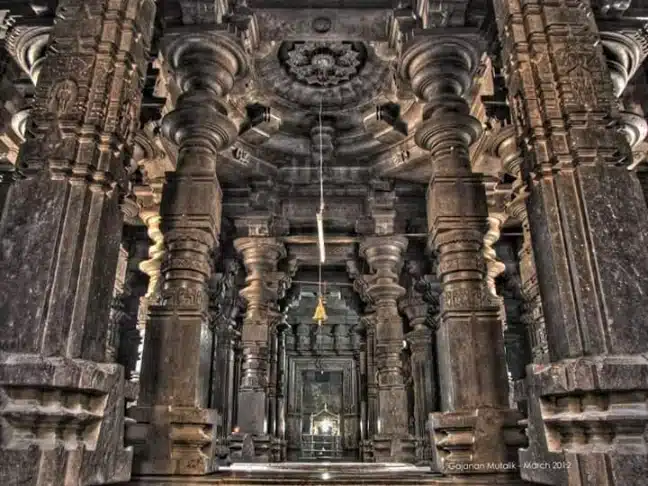
The curious case of Vishnu present alongside Shiva
Deep within the temple, resides the linga of Vishnu (Dhopeshwar) alongside the Shivling “Kopeshwar,” facing north, creating an uncommon sanctuary where followers of two contrasting sects converge. At the apex of the Swarg Mandap lies a 13-foot diameter, believed to be the gateway to heaven, where devotees could supposedly reach celestial doors. Positioned at its centre, worshippers gaze upon Brahma carved to the left, the Shivling in the center, and Vishnu to the right, embodying the holy trinity in one glance, a symbolic pathway to heaven.
Legend tells of Swarg (heaven) becoming overcrowded with sinners, prompting gods from heaven to lodge complaints with Vishnu. In response, Vishnu assumed the form of a lingam and positioned himself before the Shivling, obstructing the view and disrupting the direct route to heaven. This tale is similar to the story behind the Masroor rock-cut temple, which is also said to be built as a stairway to heaven. The Kopeshwar temple complex boasts a total of 126 pillars, each uniquely carved, with 48 pillars adorning the Swarg Mandap. Notably, the 12 main pillars within the Swarga Mandap are adorned with depictions of the Ashta Dikpala, the guardians of the directions. The South pillar features Yamraj, the lord of the South.
The unique absence of Nandi in Kopeshwar Temple
Nandi is one of Shiva’s chief attendants, occasionally depicted in sculpture as a bull-headed figure. Almost all Shiva temples in India and the world display Nandi, reclining on a raised platform generally facing the main shrine continuously staring at the god. However, the Kopeshwar Temple diverges from this norm. As per the aforementioned mythology, Nandi accompanied Sati to her father’s house, and thus, he remains absent from the temple premises, following his vow to stay by her side.
Interestingly, a solitary Nandi temple stands beyond the Krishna River in the village of Yedur, Karnataka, within a 19 km radius of Kopeshwar Temple, approximately 25 km away by road. To visit both sites with ease, you can book a Savaari cab from Belgaum. It is believed that this Nandi statue rightfully belongs to Shiva at Kopeshwar Temple, symbolising his steadfast loyalty to Sati.
The impact of Adil Shah’s vandalisation on Kopeshwar Temple
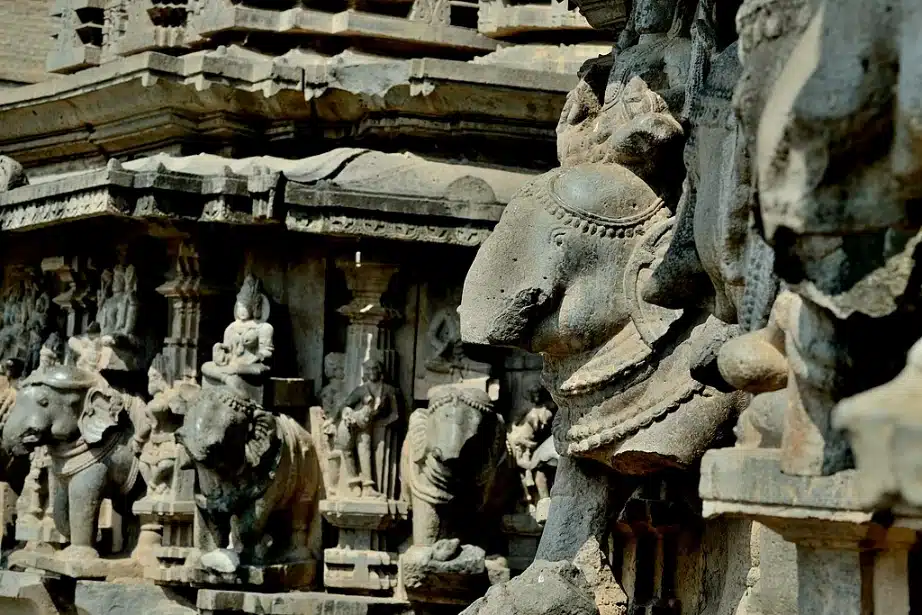
Unfortunately, many sculptures in the Kopeshwar Temple closer to the ground level have endured severe damage due to the actions of Islamic invaders. Upon observing the temple, one will notice numerous sculptures of elephants in the Gajapada with broken trunks. Legend has it that Adil Shah, the ruler of the Bijapur Kingdom, along with Islamic invaders Aurangzeb, Khyder Khan, and their armies, inflicted significant harm upon the temple carvings. They nearly obliterated all the elephant trunks.
According to the locals, it’s believed that Adil Shah’s daughter was so enamoured by the temple’s beauty that she refused to leave its premises. In response, Adil Shah marched with his army and began vandalising the temple. The daughter, promised to depart with him if he ceased the destruction. He eventually relented, leading to a halt in the temple’s devastation. This tragic tale highlights the casualty of the widespread destruction of Hindu temples that escalated after Alauddin Khilji’s invasion of the Deccan.
Challenges and prospects – The current state of Kopeshwar Temple
An investigation conducted by the International Journal of Advanced and Applied Research highlights several concerns surrounding the Kopeshwar Temple. These include the encroachment of unregulated housing developments near the temple site, unsanitary surroundings, and a complete absence of basic tourist amenities such as restrooms, accommodations, and transportation from major regional towns.
Notably, upon entering the temple premises, visitors are greeted by a plastic sign. It proclaims “Welcome to the Khajuraho of Maharashtra.” However, despite this signage, the site receives minimal publicity, presenting a significant obstacle to preserving this secluded relic. Nevertheless, amidst these challenges, one finds solace in the resilience and enduring beauty of this magnificent monument.
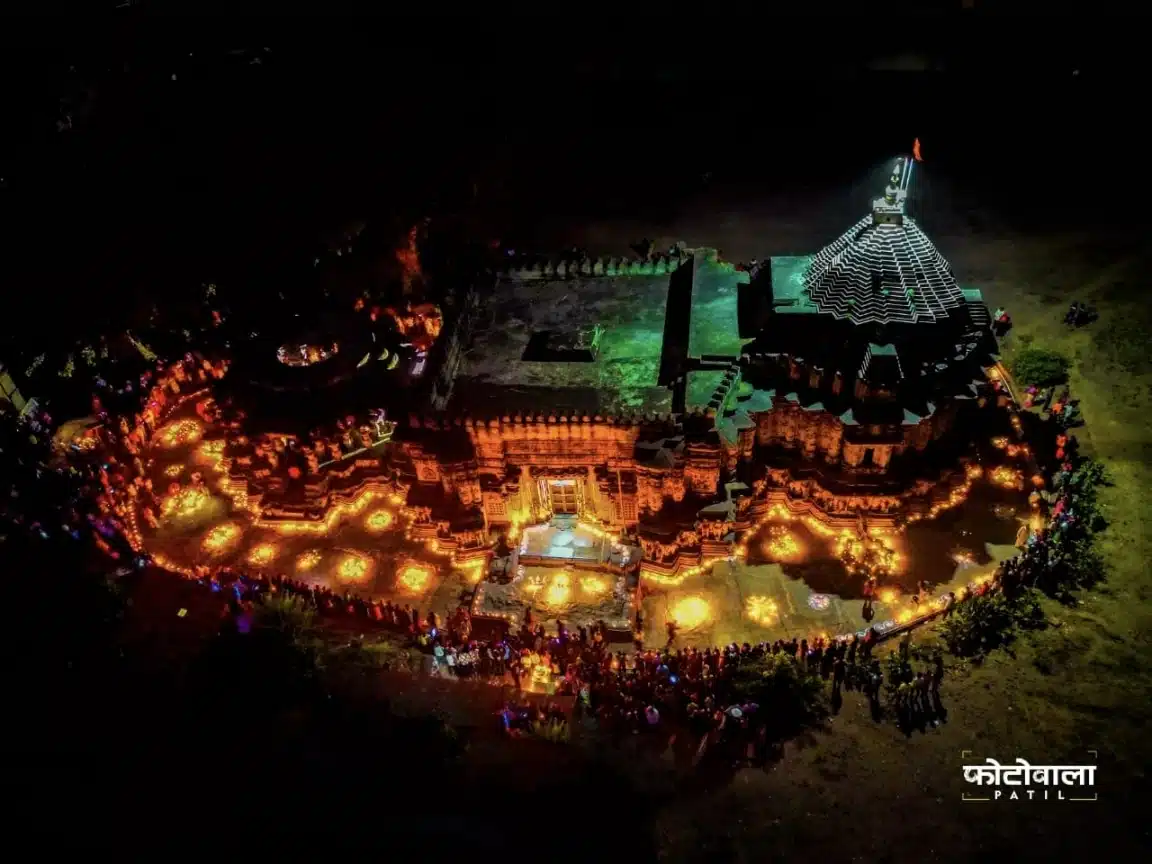
Best time to visit Kopeshwar Temple
Kopeshwar Temple offers a profoundly spiritual and serene experience throughout the year. Every Monday, a procession of the Utsav Murti takes place in the temple. Yet, for the most enchanting visit, consider planning your trip during the monsoon and winter seasons. Amidst the monsoons, the region receives moderate to heavy rainfall, transforming the surroundings into a verdant oasis of greenery. This natural spectacle infuses the temple’s ambiance with an ethereal charm, offering a refreshing retreat for visitors.
How to reach the Kopeshwar Temple
Kopeshwar Temple, also known as Khidrapur Temple, is conveniently accessible via several routes, including Kolhapur, Ichalkaranji, or Miraj.
By Air: If you’re travelling by air, the nearest airport is located in Kolhapur. Kolhapur is served by the Chhatrapati Rajaram Maharaj Airport, which is located 55 km away from Khidrapur. The Belagavi Airport is located approximately 101 km away, while Lohegaon Airport is situated 250 km away. From Belgaum Airport, you can easily book an airport taxi to reach the temple.
By Rail: For those arriving by train, Kolhapur railway station serves as the nearest railway hub. It is located about 60.6 km away via Kagal MIDC Rd. It is approximately a journey of 1 hour and 28 minutes.
By Road: Khidrapur lies merely 60 kilometers from Kolhapur and is well-connected by both public and private transportation options. The S.T. Bus Depot in Kolhapur city serves as the closest bus stop and station. However, for a more comfortable and a scenic road trip, consider booking an hourly car rental from Pune to reach the temple hassle-free.
Festivals at Kopeshwar Temple
Kopeshwar Temple is renowned for its vibrant festivals, which draw devotees seeking blessings and spiritual fulfillment. Every Monday, a procession of the Utsav Murti takes place in the temple. Among these celebrations, two stand out for their significance and grandeur in this Shiva Vishnu Temple.
- Shravana, occurring during the fifth month of the Hindu calendar, is a time of fervent devotion and auspicious rituals. It is aimed at invoking happiness and prosperity. Fasts, offerings, and chanting of mantras characterize this sacred period.
- Mahashivaratri, observed in the last week of February, commemorates the divine union of Lord Shiva and Goddess Parvati. Click here to learn more about the festival’s importance and its lesser-known legends. This fasting ritual is accompanied by elaborate ceremonies orchestrated by the temple priests and committee, culminating in a grand celebration.
Pro-tips for visiting Kopeshwar Temple
Before embarking on your journey to Kopeshwar Temple, consider these pro-tips to make the most of your spiritual experience:
1. Begin your journey early to ensure a peaceful visit and capture photographs in the Swarg Mandap before the crowds gather. The Kopeshwar temple timings are from 6 am–8 pm.
2. Respect the serene surroundings of the temple by being mindful of noise levels and refraining from littering.
3. Engage with the tour guide for insightful information about the temple. Most guides are fluent in Hindi and Marathi and offer valuable insights. You can also find buy books outside where you can learn about Khidrapur temple history in Marathi and Kannada.
4. Dress modestly and respectfully for your visit.
5. Keep in mind that there are no nearby restaurants. However, you can find snack centres offering basic refreshments like Vada Pav, Misal Pav, Bhaji, Bhaji Puri, and tea.
6. Since Khidrapur lacks lodging options, consider staying in Kolhapur for accommodation.
How to plan your trip to the Kopeshwar Temple
Planning a visit to the Kopeshwar Temple offers a chance to explore three fascinating temples in a single day. Consider booking a Savaari from Kolhapur early in the morning to kickstart your itinerary. Begin with a visit to the esteemed Mahalaxmi Temple in Kolhapur. It is a pivotal Hindu shrine dedicated to Goddess Lakshmi, revered here as the Supreme Mother Mahalakshmi. This temple is one of the three and a half Shakti Peethas mentioned in Hindu scriptures.
Continue your journey to Kopeshwar Temple with your Savaari, situated 60 km from Kolhapur. Along the route, you’ll encounter numerous eateries offering traditional Maharashtrian cuisine. You can also find fast-food options like McDonald’s for those with a craving. Dedicate about an hour and a half to immerse yourself in the temple’s splendour. Then, proceed to the Narsobawadi Temple, situated 19 km away. Narsobawadi, located at the confluence of the River Panchganga and Krishna, offers a serene pilgrimage site. Embrace the calm by spending time on the ghat steps beside the river, especially early in the morning or evening. Dining options near Kopeshwar Temple might be scarce, but you’ll find a variety of enticing vegetarian restaurants near Narsobawadi. It is perfect for satisfying your hunger after a day of exploration.
Why visit the Kopeshwar Temple with Savaari?
The Kopeshwar Temple stands as a remarkable testament to ancient architectural brilliance. Marvelling at its finely carved details, one cannot help but wonder at the ingenuity of craftsmen from past eras, whose work appears almost machine-cut in its precision. Beyond its architectural splendour, it is one of the Shiva temples in India that offers a rich tapestry of scientific data, historical significance, and religious devotion. Each compartment and idol within its walls holds stories waiting to be discovered. This makes every visit a religious pilgrimage and an enlightening journey through history.
While the road to Khidrapur may present its challenges, fear not, for downloading the Savaari app makes navigation a breeze. Your journey will be accompanied by the wisdom of your chauffeur driver, who will regale you with tales of the temple’s past. Additionally, the opportunity to explore the nearby Narsobawadi temple and Mahalaxmi temple in Kolhapur adds another layer of spiritual depth to your visit. So, embark on this extraordinary journey to Kopeshwar, and delve into the timeless beauty and wisdom encapsulated within the walls of this ancient marvel.
Last Updated on June 4, 2024 by blogadmin


